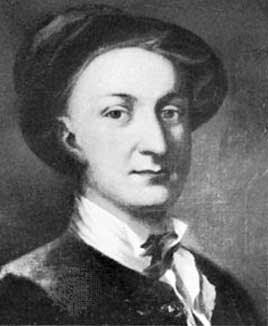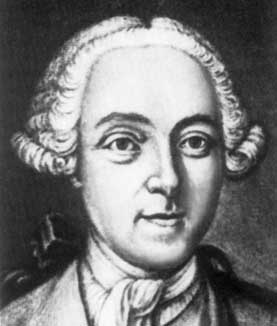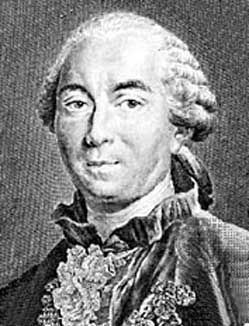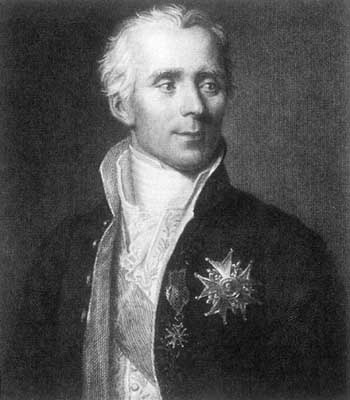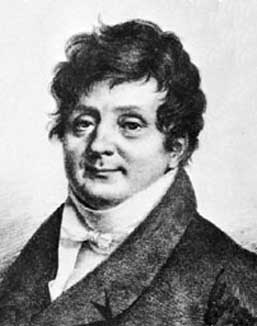James (Jacob) Bernoulli
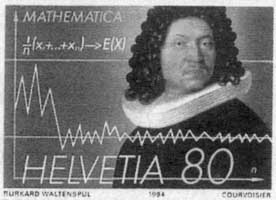
|
1654-1705 |
In Acta Eruditorum (1690),
James
Bernoulli, who began a long list of Mathematical contributions provided
by the Bernoulli family, divulged solutions to a problem that he posed in the
Journal des Scavans for 1685. The problem, as found in
Todhunter’s Theory of Probability, is as
follows: A and B play with a die, on condition that he who first throws an
ace wins. First A throws once, then b
throws once, then A throws twice, then B throws twice, then a throws three
times, then B throws three times, and so on until ace is thrown. The chances involve infinite series which
are not summed.
|
| John Arbuthnot |
1667-1735 |
John Arbuthnot from Scotland published Of the Laws of Chance (1692), which was the first publication on probability to be written in English. It also included a translation of Huygen’s work and applications to games of chance. Arbuthnot also published An argument for Divine Providence, taken from the constant Regularity observ’d in the Births of both Sexes (1709). This work discusses the chance of a male or a female being born, and the probability of more males being born in a succession of years. |
|
Roberts’ An Arithmetical Paradox, concerning the chances of Lotteries (1693) addresses chances in lotteries where there are equal expectations but unequal odds. |
||
| John Craig |
1663-1731 |
Craig, a mathematician from Scottland, published Theologiae Christianai Principia Mathematica; a calculation of the Credibility of Human testimony (1699) (written anonymously) in which he tried to apply probability to moral matters, such as the validity of the Gospels. |
|
1678-1719 |
Montmort, a wealthy Frenchman, published his work, Essai d’Analyse sur les Jeux de Hazards (1708), on Chances. It included the theory of combinations, games of chance using cards and dice, solutions to chance problems and to some of Huygen’s problems. |
|
| Nicholus Bernoulli |
1687-1759 |
Nicholus Bernoulli, from Switzerland, published Specimina Artis conjectandi, ad quaestiones Juris applicatae(1709). In this work, Bernoulli discusses probabilities of topics concerning human life, death, annuities on life, and length of life. He also addresses problems relating to lotteries, testimonies, and innocence. |
|
1667-1754 |
Abraham de Moivre, born in France but spent most of his adult life in England, published De Mensura Sortis, deu, de Probabilitate Eventuum in Ludis a Casu Fortuito Pendentibus (1709). This work is comprised of 26 problems relating to games and circumstances of chance. De Mensura Sortis was expanded to become The Doctrine of Chances: or, a Method of Calculating the Probabilities of Events in Play. |
|
|
1682-1716 |
In 1722, after his death, the Englishman, Roger cotes was recognized for his work in which he suggested that astronomers and navigators use a weighted mean to combine observations and measurements to arrive at an estimate. This proposal can also be considered as an early insight to the method of least squares. |
|
|
1702-1761 |
Thomas Bayes, an Englishman, was a nonconformist minister. He is well known for Baye’s Rule, Baye’s estimator, and Baye’s risk. Although no papers were published under his true name until after his death, he initiated the idea of reasoning from specifics to generalities in probability theory. After his death, Essay towards solving a problem in the doctrine of chances (1764) was published from which we get Bayesian estimation. |
|
| Leonhard Euler |
1707-1783 |
Leonhard Euler, a Swiss mathematician, has been considered one of the most influencial mathematicians of the 18th century (as was Lagrange). Euler made many contributions to mathematics as well as introducing the beta and gamma functions, which are widely used in statistics today. |
|
1707-1788 |
Georges Buffon, a naturalist from France, adamantly opposed to gambling, published an essay Essai d’Arithmetique Morale (1777). In this essay, Buffon discusses different categories of truths, argues that the amount that one can lose is too great to consider playing a game of chance, expounds on the Petersburg Problem (This is a problem in which two players are tossing a shilling. The first player tosses the coin, and if the result is a head the second player owes the first player a shilling. If the toss results in a tails, the first player tosses the coin again, but on the occurrence of a head on this toss, the second player owes the first two shillings, and so on, increasing the number of shillings owed.), and applies geometry and integral calculus to problems involving probabilities. Buffon supported many of his claims through extensive experimentation, such as tossing a coin thousands of times, and throwing a rod (needle) or a cube onto a tiled surface in order to calculate the probability that the rod or the cube will land so that it is touching one of the lines. Buffon used the results of these experiments to estimate pi. He also did much work on Mortality tables in which he considers the duration of life. |
|
|
1749-1827 |
Laplace,
born in France, can be said to have made the most
influential impact on the advancement of probability (as well as in other
areas of science) in history. Laplace
published Theorie
analytique des Probabilites (1812) in which he
included many of his previously published memoirs and new ideas on
probability. This was used as the
model text for advanced probability during the 19th century, and
has been referred to as “one of the most splendid works of the greatest
mathematician of the past age.”
|
|
|
1752-1833 |
Legendre,
was a Frenchman and became the first to publish the
method of least squares in Nouvelles methods pour la determination des
orbites des cometes (1805). Guass later attributed this discovery to his own credit, much to the
dismay of Legendre. This method,
which uses existing data to fit a curve, was quickly adopted and employed in
many fields, especially astronomy and geodesy.
|
|
| Jean Baptiste Joseph Fourier |
1768-1830 |
Jean Baptiste Joseph Fourier was born in France and had several interesting encounters during the French Revolution, such as being arrested twice and barely escaping the guillotine. He studied under Lagrange, Laplace, and Monge at the Ecole Normale in Paris. He was the scientific advisor to Napolean when he invaded Egypt, and became stranded there when the French fleet was destroyed in the Battle of the Nile. He helped found the Cairo Institute and worked in the Mathematics division. This is where he first began to work on his famous Fourier series. While serving as Prefect of the Department of Isere (1807), a position appointed to him by Napolean, he presented his memoir On Propagation of Heat in Solid Bodies (1807), which caused quite a stir due to the introduction of the Fourier series, which he used to expand functions to trigonometric series. Laplace and Lagrange severely criticized his work, which we now know to have a huge impact on the Theory of Functions of Real Variables. This work was finally published in Theorie Analytique de la Chaleur (1822)(The Analytical theory of Heat). |
